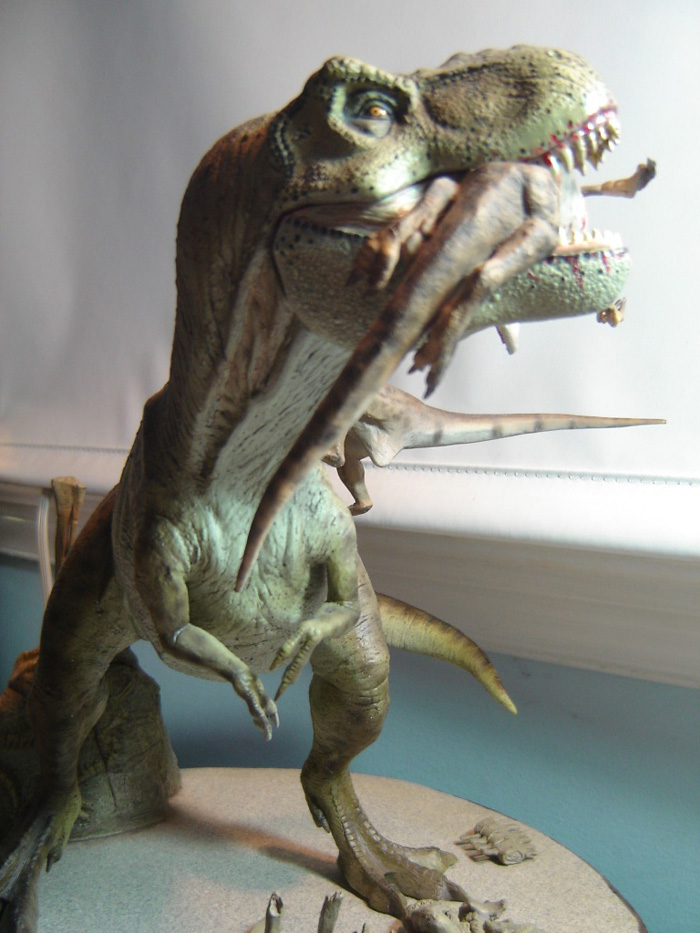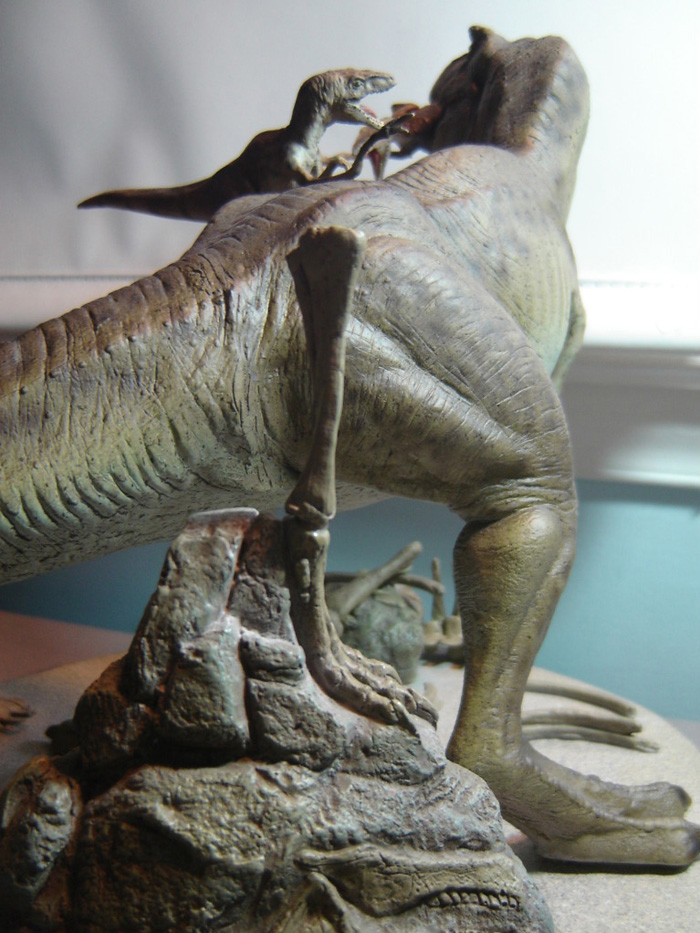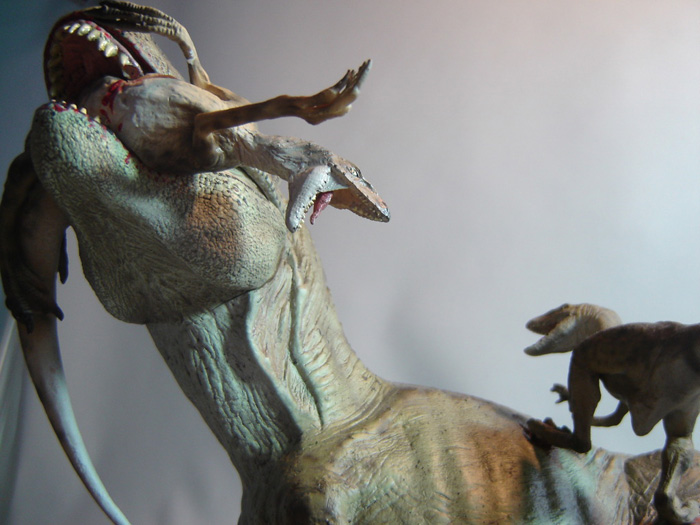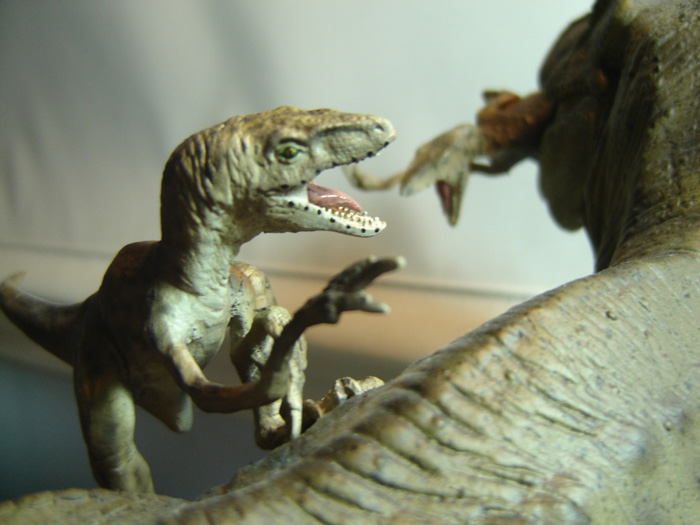dansdinosaurs
Super Freak
[ Mods, feel free to move this to the review section, thanks. ]
Jurassic Park “When Dinosaurs Ruled The Earth” T-Rex vs. Velociraptors Diorama (by Sideshow Collectibles)
Review and photos by Dan Liebman of DansDinosaurs.com.
It is hard to believe that Crichton’s bestselling novel first appeared two decades ago. Since that time, the franchise has reintroduced audiences to dinosaurs like never before. Gone were the bulky, sluggish monsters of yesteryear, and in their place were lighting-fast predators with frightening levels of intellect. Granted, popular media depictions of dinosaurs are rarely known for their adherence to well-established scientific research, but that scarcely mattered. Jurassic Park is often credited with reenergizing the field and funding of paleontological studies around the world.

To no one’s great surprise, Sideshow Collectibles – which has a reputation for closely collaborating with popular film studios – gained considerable attention after announcing the acquisition of one the Jurassic Park license. Their first piece, a polystone diorama statue, was released in 2008. This model depicts the climactic final battle of the first film, in which the human characters find themselves caught between two fearsome Velociraptors, only to be saved at the last second by the intervention of a hungry Tyrannosaurus rex. This jaw-dropping scene elicited countless screams and cheers from audiences around the globe, and is arguably one of the most memorable moments in cinematic history.

This diorama has been appropriately titled “When Dinosaurs Ruled The Earth”, based on the famous banner that drops in the final shot of the Tyrannosaurus shown in Jurassic Park. The extended version of this product’s title may also include “Tyrannosaurus vs. Velociraptors”. This is a slightly humorous label, given the rather low probability of victory that exists for the smaller carnivores in the scene. Several editions of this statue have been released, including one in faux bronze, and another that includes a miniature version of the aforementioned banner.
Knowing that dinosaurs always manage to steal the show anyway, the artists at Sideshow did not bother to include any human figures in their recreation. The entire scene is built upon a heavy base bearing the tropical “Jurassic Park” logo, staged on the smooth flooring of the visitor center’s main lobby. Shattered replicas of dinosaur bones are scattered across the scene, realistically damaged just as they were during the film’s final battle. Even the large block of “fossil matrix” contains the familiar array of skeletons, such as a Brachiosaurus skull.

The model requires only a few bits of assembly. Aside from attaching the Tyrannosaurus to the base, the large carnivore’s lower jaw locks into place magnetically, with a screaming Velociraptor already attached. The second raptor completes the image, with its pegged foot sliding into place on the Rex’s left flank. The final result is a scene frozen in time, which although chronologically awkward, reveals a titanic predator with a fearsome creature caught in its jaws, and a second scrambling up its exposed side.
Given the popularity of these animals, it is a bit disappointing that the final paint job seems to deviate substantially from the film version. During the final scene in the film, these animals are generously illuminated and often appear just a few meters away from the camera. These predators are not reproduced in their original lustrous browns and rich ambers; instead, both species appear predominantly grey. Some might contend that this natural color scheme is acceptable and realistic when compared to some of the more “progressive” colorations seen in modern dinosaur reconstructions. From an aesthetic standpoint, the somewhat monochromatic “old film” quality draws special attention to the bloodied jaws and neon logo at the display base. Even so, this simple paint scheme came as a surprise to me, particularly when one considers the cost of the item. The Tyrannosaur’s dorsal coloration is predictably darker than its ventral side, but the only detailed painting appears in the form of black spots framing the head. This also appears on the raptors, as if the painters decided to go with an entirely new makeup artist for the film’s stars. This choice of paint application may deter Jurassic Park purists, but it is the only significant fault I can find with this statue.

As a sculpture, this piece is quite impressive. It appears to around the 1:20 scale (perhaps less, given how large the JP Rex was) and displays quite nicely alongside other dinosaurs models of this scale. Sculptural details are still very strong, from the wrinkles and muscles of the powerful bodies to the tiny teeth lining the jaws of the raptors. The Tyrannosaur’s tail is dynamically curled, an organic way of framing the scene and drawing the eye to the central action. This is, like many aspects of the scene, not considered to be scientifically accurate by today’s standards. However, it would not be fair to assess a Jurassic Park statue on the merits of modern paleontological findings; this statue is, above all else, a recreation of a famous film scene.

In the mighty jaws of the Rex, the first raptor struggles vainly. Here is the first instance I can recall in which this animal was depicted in a sympathetic manner, its limbs flailing wildly with the jaws widened to their maximum capability (perhaps even beyond), likely emitting that famously shrill “dolphin” scream. The trunk of the raptor’s body is visibly crushed, its flesh smashed painfully as vibrant blood pours from its doomed husk. This is perhaps a more graphic depiction than shown in the film, although not excessively so. The second raptor appears to have only recently leapt onto the larger carnivore, inflicting shallow lacerations that would likely serve only to irritate the super predator. The recent timing of the attack is also conveyed in the stance of the Tyrannosaur; she either has yet to acknowledge to the harassing raptor, or simply does not care. Moreover, there is an almost boastful quality to her stance, as if reasserting her position in the food chain millions of years after her passing.
For the typical spectator, the scene is instantly recognizable. Despite its flaws, there is little doubt that this piece reawakens past memories of the film. For a truly cinematic presentation, I suggest playing the Jurassic Park theme music as guests enter the exhibition room. This statue successfully projects the wonder and awe of the original film. It should be noted that, due to its size and fragility, this piece should not displayed where children are running about. Additionally, there are several sharp and pointed areas of the statue that might pose a threat to rambunctious juveniles, primarily in the claws and pointed tails of the raptors.

A year following the release of this statue, Sideshow began offering an original product line known as Dinosauria. Because these newer figures are not based on any film, and are the product of careful collaboration with paleoartists, I do not believe it would be fair to compare them with this first attempt by Sideshow to capture the majesty of the prehistoric world. It may not possess the scientific authenticity and aesthetic detail of the Dinosauria statues, but Sideshow’s “When Dinosaurs Ruled The Earth” diorama is certainly guaranteed to turn heads.
Jurassic Park “When Dinosaurs Ruled The Earth” T-Rex vs. Velociraptors Diorama (by Sideshow Collectibles)
Review and photos by Dan Liebman of DansDinosaurs.com.
It is hard to believe that Crichton’s bestselling novel first appeared two decades ago. Since that time, the franchise has reintroduced audiences to dinosaurs like never before. Gone were the bulky, sluggish monsters of yesteryear, and in their place were lighting-fast predators with frightening levels of intellect. Granted, popular media depictions of dinosaurs are rarely known for their adherence to well-established scientific research, but that scarcely mattered. Jurassic Park is often credited with reenergizing the field and funding of paleontological studies around the world.

To no one’s great surprise, Sideshow Collectibles – which has a reputation for closely collaborating with popular film studios – gained considerable attention after announcing the acquisition of one the Jurassic Park license. Their first piece, a polystone diorama statue, was released in 2008. This model depicts the climactic final battle of the first film, in which the human characters find themselves caught between two fearsome Velociraptors, only to be saved at the last second by the intervention of a hungry Tyrannosaurus rex. This jaw-dropping scene elicited countless screams and cheers from audiences around the globe, and is arguably one of the most memorable moments in cinematic history.

This diorama has been appropriately titled “When Dinosaurs Ruled The Earth”, based on the famous banner that drops in the final shot of the Tyrannosaurus shown in Jurassic Park. The extended version of this product’s title may also include “Tyrannosaurus vs. Velociraptors”. This is a slightly humorous label, given the rather low probability of victory that exists for the smaller carnivores in the scene. Several editions of this statue have been released, including one in faux bronze, and another that includes a miniature version of the aforementioned banner.
Knowing that dinosaurs always manage to steal the show anyway, the artists at Sideshow did not bother to include any human figures in their recreation. The entire scene is built upon a heavy base bearing the tropical “Jurassic Park” logo, staged on the smooth flooring of the visitor center’s main lobby. Shattered replicas of dinosaur bones are scattered across the scene, realistically damaged just as they were during the film’s final battle. Even the large block of “fossil matrix” contains the familiar array of skeletons, such as a Brachiosaurus skull.

The model requires only a few bits of assembly. Aside from attaching the Tyrannosaurus to the base, the large carnivore’s lower jaw locks into place magnetically, with a screaming Velociraptor already attached. The second raptor completes the image, with its pegged foot sliding into place on the Rex’s left flank. The final result is a scene frozen in time, which although chronologically awkward, reveals a titanic predator with a fearsome creature caught in its jaws, and a second scrambling up its exposed side.
Given the popularity of these animals, it is a bit disappointing that the final paint job seems to deviate substantially from the film version. During the final scene in the film, these animals are generously illuminated and often appear just a few meters away from the camera. These predators are not reproduced in their original lustrous browns and rich ambers; instead, both species appear predominantly grey. Some might contend that this natural color scheme is acceptable and realistic when compared to some of the more “progressive” colorations seen in modern dinosaur reconstructions. From an aesthetic standpoint, the somewhat monochromatic “old film” quality draws special attention to the bloodied jaws and neon logo at the display base. Even so, this simple paint scheme came as a surprise to me, particularly when one considers the cost of the item. The Tyrannosaur’s dorsal coloration is predictably darker than its ventral side, but the only detailed painting appears in the form of black spots framing the head. This also appears on the raptors, as if the painters decided to go with an entirely new makeup artist for the film’s stars. This choice of paint application may deter Jurassic Park purists, but it is the only significant fault I can find with this statue.

As a sculpture, this piece is quite impressive. It appears to around the 1:20 scale (perhaps less, given how large the JP Rex was) and displays quite nicely alongside other dinosaurs models of this scale. Sculptural details are still very strong, from the wrinkles and muscles of the powerful bodies to the tiny teeth lining the jaws of the raptors. The Tyrannosaur’s tail is dynamically curled, an organic way of framing the scene and drawing the eye to the central action. This is, like many aspects of the scene, not considered to be scientifically accurate by today’s standards. However, it would not be fair to assess a Jurassic Park statue on the merits of modern paleontological findings; this statue is, above all else, a recreation of a famous film scene.

In the mighty jaws of the Rex, the first raptor struggles vainly. Here is the first instance I can recall in which this animal was depicted in a sympathetic manner, its limbs flailing wildly with the jaws widened to their maximum capability (perhaps even beyond), likely emitting that famously shrill “dolphin” scream. The trunk of the raptor’s body is visibly crushed, its flesh smashed painfully as vibrant blood pours from its doomed husk. This is perhaps a more graphic depiction than shown in the film, although not excessively so. The second raptor appears to have only recently leapt onto the larger carnivore, inflicting shallow lacerations that would likely serve only to irritate the super predator. The recent timing of the attack is also conveyed in the stance of the Tyrannosaur; she either has yet to acknowledge to the harassing raptor, or simply does not care. Moreover, there is an almost boastful quality to her stance, as if reasserting her position in the food chain millions of years after her passing.
For the typical spectator, the scene is instantly recognizable. Despite its flaws, there is little doubt that this piece reawakens past memories of the film. For a truly cinematic presentation, I suggest playing the Jurassic Park theme music as guests enter the exhibition room. This statue successfully projects the wonder and awe of the original film. It should be noted that, due to its size and fragility, this piece should not displayed where children are running about. Additionally, there are several sharp and pointed areas of the statue that might pose a threat to rambunctious juveniles, primarily in the claws and pointed tails of the raptors.

A year following the release of this statue, Sideshow began offering an original product line known as Dinosauria. Because these newer figures are not based on any film, and are the product of careful collaboration with paleoartists, I do not believe it would be fair to compare them with this first attempt by Sideshow to capture the majesty of the prehistoric world. It may not possess the scientific authenticity and aesthetic detail of the Dinosauria statues, but Sideshow’s “When Dinosaurs Ruled The Earth” diorama is certainly guaranteed to turn heads.




